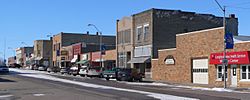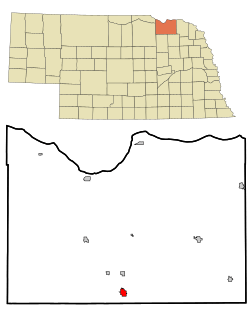Creighton, Nebraska facts for kids
Quick facts for kids
Creighton, Nebraska
|
|
|---|---|

Downtown Creighton: north side of Main Street looking west from Chase Avenue
|
|

Location of Creighton, Nebraska
|
|
| Country | United States |
| State | Nebraska |
| County | Knox |
| Area | |
| • Total | 1.21 sq mi (3.13 km2) |
| • Land | 1.21 sq mi (3.13 km2) |
| • Water | 0.00 sq mi (0.00 km2) |
| Elevation | 1,647 ft (502 m) |
| Population
(2020)
|
|
| • Total | 1,147 |
| • Density | 947.93/sq mi (366.01/km2) |
| Time zone | UTC-6 (Central (CST)) |
| • Summer (DST) | UTC-5 (CDT) |
| ZIP code |
68729
|
| Area code(s) | 402 |
| FIPS code | 31-11230 |
| GNIS feature ID | 837947 |
Creighton is a city located in Knox County, Nebraska, in the United States. In 2020, about 1,147 people lived there. It is a small, friendly community with a long and interesting history.
Contents
History of Creighton
How Creighton Started
The city of Creighton began with a group of settlers called the "Bruce Colony" in 1871. In 1874, they officially planned out the northern part of what is now Main Street. People aren't entirely sure how the town got its name. Some say it was named after Edward Creighton, while others believe it was for John Creighton, who also has Creighton University named after him. The most likely story is that it was named after the "Creighton family of Omaha."
In the early days, people brought food and supplies to Creighton by wagon. They often traveled in winter when rivers were frozen, making them easier to cross.
The Railroad Arrives
The arrival of the railroad in 1881 was a big deal for Creighton. It meant the town would definitely survive and grow. The railroad also caused a nearby town called Bazile Mills to almost disappear.
In 1882, Main Street was made wider, and more areas were added to the town. Creighton officially became an incorporated city that year.
Healthcare in Creighton
Dr. George Roberts opened a medical center in Creighton that served the community until 1920. For 33 years, the town didn't have a hospital. Then, in 1953, the Lundberg family and other caring citizens built a new, modern hospital. This hospital is still the only one in Knox County today.
Weather Challenges
People in Creighton have faced tough weather over the years. There are many stories about brave people during the huge blizzard of 1888. More recently, the winter of 1948–49, which started with a big snowstorm in November, reminded everyone how important weather is in northeast Nebraska.
Early Services and Businesses
A local newspaper started in 1889. That same year, a fire destroyed a whole block of businesses downtown. This led to a special system being built to fight fires. It took water directly from Bazile Creek and stored it in a wooden tower. In 1894, a volunteer fire department was formed. Today, this department is still one of the best-equipped for a city of Creighton's size.
The first electric service in Creighton began in 1890, started by Fred Largen and Andy Schneider. Later, Largen made many different items, like movie projectors and irrigation nozzles. The Creighton Bottling Works also started making soda pop. In 1899, M.C. Theisen and Mr. Diehl brought telephone service to the town.
Growth and Improvements
Creighton became a "second class city" in 1907. That year, a two-story brick school was built in the southern part of town. Getting enough water for homes was a problem until 1913, when a new water system was put in place.
A public library was built in 1914. It was replaced in the 1960s by a new one donated by the Hengstler family. A city hall, built in 1916, is still used for city offices and many community events. After World War I, the town grew a lot. In 1923, Creighton started receiving electricity from a larger power system, which is now part of NPPD. NPPD even built its headquarters in Creighton in 1960.
Modern Times
The 1930s were a difficult time for many banks and businesses. The Bank of Creighton was one of the last in the county to close. After it reorganized, it paid almost all the money back to its customers.
As electricity became available in rural areas, Creighton expanded with new businesses and homes. In the 1950s, passenger train service ended, but natural gas became available. The city also started paving its streets and built a modern swimming pool. In the 1960s, local schools joined together, and a new high school was opened in 1962.
The town continued to grow, reaching its largest population of 1,461 people in 1970. More water supply, hospital space, and street improvements were needed. A big event was Creighton's 100th birthday celebration, which lasted a whole week! It included parades, a pageant, and lots of fun for everyone. Since farming is the main industry, Creighton's economy changes along with the rural area.
Geography
Creighton covers a total area of about 1.21 square miles (3.13 square kilometers). All of this area is land.
Population Information
| Historical population | |||
|---|---|---|---|
| Census | Pop. | %± | |
| 1880 | 10 | — | |
| 1890 | 822 | 8,120.0% | |
| 1900 | 909 | 10.6% | |
| 1910 | 1,373 | 51.0% | |
| 1920 | 1,446 | 5.3% | |
| 1930 | 1,388 | −4.0% | |
| 1940 | 1,272 | −8.4% | |
| 1950 | 1,401 | 10.1% | |
| 1960 | 1,388 | −0.9% | |
| 1970 | 1,461 | 5.3% | |
| 1980 | 1,341 | −8.2% | |
| 1990 | 1,223 | −8.8% | |
| 2000 | 1,270 | 3.8% | |
| 2010 | 1,154 | −9.1% | |
| 2020 | 1,147 | −0.6% | |
| U.S. Decennial Census | |||
2010 Census Details
In 2010, there were 1,154 people living in Creighton. These people lived in 538 households, and 299 of those were families.
- About 23.8% of households had children under 18 living with them.
- 43.7% of households were married couples.
- About 41.4% of all households were made up of people living alone.
- 25.7% of households had someone 65 years or older living alone.
The average age of people in Creighton was 47.7 years.
- 22.4% of residents were under 18 years old.
- 30.2% of residents were 65 years or older.
- About 44.9% of the population was male, and 55.1% was female.
Notable People
Some well-known people have come from Creighton:
- Joseph G. Hanefeldt - A Roman Catholic bishop.
- Tony Wragge - An American football player.
Climate
Creighton has a type of climate called a humid continental climate. This means it has big changes in temperature throughout the year. Summers are warm to hot and often humid, while winters are cold, sometimes very cold.
| Climate data for Creighton, Nebraska | |||||||||||||
|---|---|---|---|---|---|---|---|---|---|---|---|---|---|
| Month | Jan | Feb | Mar | Apr | May | Jun | Jul | Aug | Sep | Oct | Nov | Dec | Year |
| Mean daily maximum °C (°F) | −1 (31) |
2 (36) |
9 (48) |
17 (62) |
23 (74) |
29 (84) |
31 (88) |
30 (86) |
26 (78) |
18 (65) |
8 (47) |
1 (34) |
16 (61) |
| Mean daily minimum °C (°F) | −13 (9) |
−10 (14) |
−4 (24) |
2 (36) |
9 (48) |
14 (58) |
17 (62) |
16 (60) |
11 (51) |
3 (38) |
−4 (25) |
−10 (14) |
3 (37) |
| Average precipitation mm (inches) | 13 (0.5) |
18 (0.7) |
38 (1.5) |
66 (2.6) |
97 (3.8) |
100 (4.1) |
79 (3.1) |
79 (3.1) |
64 (2.5) |
43 (1.7) |
25 (1) |
18 (0.7) |
620 (24.4) |
| Source: Weatherbase | |||||||||||||
See also
 In Spanish: Creighton (Nebraska) para niños
In Spanish: Creighton (Nebraska) para niños

